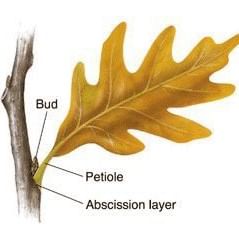Abscisic Acid | Biology for ACT PDF Download
Abscisic Acid (ABA C15H20O4)
First indication of growth inhibitors was given by Osborne.
First growth inhibitor was identified by Bennet-Clark and Kefford (1953) from dormant potato tuber and called it b-inhibitor.
Addicott & Okhuma (1963) obtained from mature cotton fruits and named as Abscisin II.(C15H20O4)
Waring & Robinson – Isolated a growth inhibitor from old Betula leaves & called as dormin.
 Leaf Abscission
Leaf AbscissionLater establised that b-inhibitor, Abscisin-II and dormin are same and called as Abscisic acid.
ABA is the most wide spread growth inhibitor in plants.
ABA synthesized by Mevalonic acid pathway & oxidation of carotenes in chloroplasts.
ABA also known as stress hormone, because it protects plants from adverse conditions like water stress. ABA increases tolerance of plants to various type of stresses.
Physiological effects and applications
(1) Induce abscission – ABA causes ageing and abscission of leaves & fruits (antiauxin) (cellulase & pectinase genes induced by ABA)
(2) Induce bud & seed dormancy – ABA regulates (anti–GA) bud & seed dormancy.
ABA plays a major role in seed maturation enabling seeds to become dormant.
(3) Induce senescence – ABA accelerates senescence of leaves.
(4) Inhibition of cell division & cell elongation – anti CK.
(5) Stomatal closing – ABA causing the stomatal closing under the water stress conditions. Increases resistance to frost injury. (anti transpirant & stress hormone)
(6) Delaying of flowering in LDP.
(7) Tuberisation in potato.
(8) Inhibitor of a–amylase synthesis – Inhibition of seeds germination.
(9) Geotropism in roots.
ETHYLENE
H.H Cousin first suggested, that ripened oranges are responsible for ripening of unripe bananas.
Ethylene is a gaseous pollutant hydrocarbon, but Burg reported it as a fruit ripening hormone.
Pratt Goeschl – Recognized ethylene as a natural plant growth regulator.
Biosynthesis of ethylene takes place by methionine amino acid. Ethylene is synthesized in large quantity by ripening fruits and senescent organs. *
Ethylene also formed in roots in water logged condition.
Physiological effects and applications
(1) Post harvest ripening of fruits – Citrus, oranges, banana, apple, tomato. today ethephon/CEPA (Chloroethyl Phosphonic acid) used at commercial level.
(2) Stimulation of senescence & abscission of leaves. Ethylene is synthesized in large quantity by ripening fruits and senescent organs.
(3) Flowering in pineapple.
(4) Triple response on stem :-
(i) Inhibition of stem elongation
(ii) Stimulation of radial swelling of stem
(iii) Horizontal growth of stem (ageotropism)
(5) Inhibits root growth :- Ethylene is inhibitor of root growth but stimulates the formation of root hairs.
(6) Epinasty of leaves.
(7) Femaleness (Feminising effect) Pineapple (Bromeliaceae).
(8) Tightening of hooks of epicotyl and hypocotyl.
(9) Inhibits the polar movement of auxin.
Other growth regulating substances
Wound hormone Traumatic Acid :- Induce callus formation on injured parts (healing of wounds) Chemically traumatic are auxin like substance.
Calines (Formative hormones)
(i) Rhizocalines :- Produced by leaves & induce formation of roots.
(ii) Caulocalines :- Produced by roots & induce formation of stem.
(iii) Phyllocalines :- (Self forming hormone) produced in cotyledons & leaves, induce division of leaf mesophylls.
Morphactins or (HFCA) These are, synthetic growth inhibitors, which are polyvalent (wide range) in action
(i) Inhibition of internode elongation
(ii) Reduction of apical dominance & promotion of lateral branching
(iii) Reduces the laminar area of leaf.
(iv) Abolition of phototropism
Chlormequat (CCC or Cycocel):- Growth inhibitor, which is used in bonsai.
Alar - 85 (B-Nine):- in floriculture
Agent orange :- Mixure of 2,4-D & 2,4,5-T used in bio–war. (Used by U.S.A. in Vieatnam war)
Amo - 1618 :- in biowar.
Phosphon-D, Cycocel, Amo-1618, Alar-85, Ancymidol (A-REST) are antigibberellins and cause inhibition to stem growth.
|
208 videos|226 docs|136 tests
|
FAQs on Abscisic Acid - Biology for ACT
| 1. What is the role of abscisic acid in plants? |  |
| 2. How does abscisic acid control seed dormancy? |  |
| 3. Can abscisic acid help plants cope with drought stress? |  |
| 4. How does abscisic acid regulate stomatal closure? |  |
| 5. Is abscisic acid involved in plant responses to environmental stressors other than drought? |  |
















